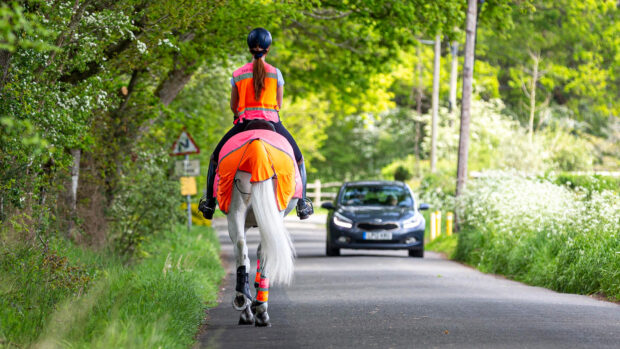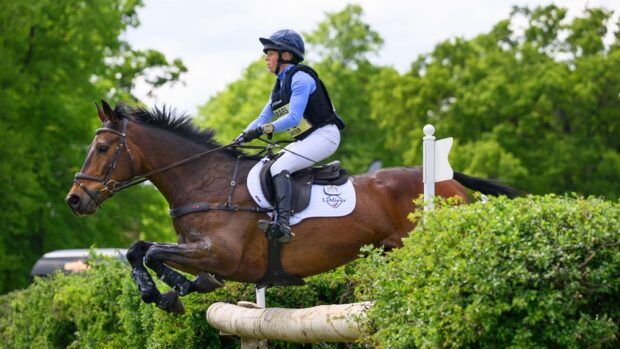Q: Hot or “reactive” horses — achieving relaxation without tiredness — “I have a young ex-racehorse who I would also describe as “reactive”. He has phases where he is very calm and takes things in his stride, but does seem to go through cycles of being very hot, tense and generally ready to explode at any given moment. Out of necessity, some days he has worked really hard, but the next day he comes out still breathing fire.
“Anyway, I was chatting to a friend about him a few weeks ago and I got myself thinking. Obviously, it is not ideal to have to work a young horse very hard. It also doesn’t seem to be the way to improve his rideability. We tried hard work for a month or so, and this tends to be everyone’s go-to option, but with him still being difficult, something had to change (important to note at this point that yes, saddles/teeth/back etc have all been checked and are fine). Working harder wasn’t fixing the problem, tiring the horse just made him fitter in the long run, and it also isn’t necessarily a true reflection of a relaxed horse. I know I don’t feel relaxed after a long run at the gym, even if I’m exhausted!
“So, how exactly do you work towards relaxing a horse rather than tiring it out? You obviously want the horse to be focused and rideable, but still have enough energy to perform. And of course, nobody wants to have to do an hour of work before your horse can canter in a sensible manner.
“Say you have a very buzzy youngster, a reactive horse who has just come off box rest, or a horse who can’t be too tired to do its job at a more advanced dressage or jumping show but isn’t a naturally relaxed type? I have changed my approach quite drastically over the past few weeks, but I would like to hear other people’s opinions. Our work has largely focused on slowing things down, being very deliberate in everything we do, and really going back to super basic stuff.”
A: Horses that are naturally busy take time and some need to be taught how to relax. Routine is very important all the way down to when they are fed, what time they are turned out and with who.
One of the most important parts of my management routine with horses like this is tying up. They will spend an hour or so in the day standing on the tie waiting for me. This helps because horses like this have a very active mind and don’t naturally switch off so they need to be taught how to switch off and this is a good way of doing it. Give them some time tied up every day, an hour or more and you would see a difference. Some will start off fidgeting and trying to get your attention by scrapping the floor — basically it’s just that busy energy that they carry expressing itself and as long as they are not doing themself any harm, leave them alone. Try not to keep going over to pet them or tell them off as this is just rewarding that behaviour (a bit like with a child who is attention seeking, any form of attention is a reward!).
Continued below…
Related articles:
- H&H forum: find out what H&H readers suggested
- Find out more on horse training
- Essentials for starting a young horse
I use a piece of equipment called a Safe Tie which you can see in use on my online training resource Your Horsemanship. This enables horses to be tied safely and would put your mind at rest that when they are being fidgety or silly that they won’t come to serious harm. So that’s the first tip — give them some tying up time each day and a chance to learn to relax.
Then when I’m riding this type of horse, I like to simply spend time in the saddle and put some miles on them without pressure. I teach from them for a couple of hours a day whenever I can. I realise this is not possible for a lot of people, but I have had a lot of success with this method.
When I’m teaching I spend most of the time standing and instructing, following the student or demonstrating something. Most importantly, I am not focused on the horse I’m riding. If they won’t stand still, I spend a lot of time walking in circles, which is a form of winding them down and helps them relax. They all eventually stand and let go of the tension, but it can test your perseverance. So make time to do this — perhaps a friend needs some help and you can just use your horse as an arm chair while you teach them or watch their session. This way there is no pressure on your horse and the time spent sitting on them and winding them down is the best time you can give them at the moment.
Using this type of riding and management can make your horse tired, but it is a different type of tiredness to exhaustion.
I was raised back on my dad’s farm in Australia and we didn’t come across this problem with the horses there because they spent long days mustering cattle which settled them down quickly without putting undue pressure on them physically. It is this time in the saddle that you need to try and replicate rather than lots of hard work and cantering in the school. I call it putting miles on your horse, but the right sort of miles! Give these tips a try and see how you go.
Jason
For more information on Jason Webb visit his online training base Your Horsemanship, where you can learn a foundation in horse training with online lessons in groundwork, starting, and ridden fundamentals




